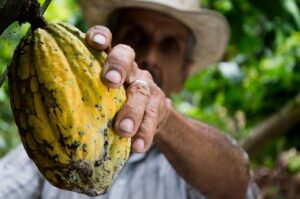COCOA
September Cocoa traded to its highest level since April 26 yesterday and came within $807 of the contract high from April 19. Sources told Reuters that Ivory Coast’s Coffee and Cocoa Council (CCC) has halted forward sales of their 2024/25 crop at 940,000 metric tons as they wait for more clarity on expected production. CCC typically sells around 70% of its harvest in order to fix a guaranteed minimum price for farmers. Ivory Coast oversold their 2023/24 main crop (which runs from October to March), which forced them to roll contracts of 150,000 tons into the April-September mid-crop. The 940,000 tons they have already sold is 35% less than had sold at this time last year. Weather seems to have improved, but other, structural issues are present, such as swollen shoot disease, which is damaging trees. This came a day after it was reported that Ghana was looking to roll 350,000 metric tons of pre-sold cocoa to the 2024/25 season, up from a previous expectation of 250,000. This brought back talk of cocoa buyers being stuck, unable to secure supplies. The 15-day forecast calls for above normal rainfall across the main cocoa growing regions of West Africa, plus Indonesia. Current topsoil moisture in Ivory Coast is at the low end of the five-year range. The rains could help output eventually, but do chocolate manufacturers have enough in reserve. Mondelez says it aims to keep prices down to protect demand, as it awaits lower cocoa prices next year.

SUGAR
October Sugar was slightly lower overnight after breaking out to the upside of a three week sideways pattern yesterday, leaving the May high in its sights. Unica is expected to release its update on Brazilian sugar for the second half of May any day, and a survey of analysts by S&P Global has expectations for Center-South production to be down 0.8% from a year ago at 2.9 million metric tons. Traders will be also be watching the sugar mix, as the last report showed only 48.3% of the cane crop processed for sugar versus expectations of 51.7%. For this report, the average expectation calls for 49.8%. La Niña arriving this summer and lasting into late this year could bring drier than normal conditions to Brazil Center-South and wetter than normal to Thailand and India. This presents a mixed bag on the production front. An analyst with Hedgepoint said yesterday they expect sugar to remain in surplus next year barring a strong La Niña event.
COFFEE
Coffee prices have fell slightly this week in Vietnam, which pulls support away from NY arabica prices as well. Farmers in the central highlands were selling robusta beans for 120,000-121,000 dong, slightly lower than 123,500-125,000 last week. The US Climate Prediction Center is giving La Niña a 65% chance to develop during July-September and an 85% chance of it lasting into November-December. La Niña typically brings less moisture and colder temperatures than normal to coffee growing areas of Brazil, which could increase the chance of frost, especially later in the season, but they also bring wetter than normal conditions to Southeast Asia, which could benefit Vietnam. ICE exchange stocks increased by 3,189 bags yesterday to 808,067, up 9,384 from the previous week. The Brazilian arabica harvest began last month and will last into August. Early reports had farmers complaining about small bean sizes after the dry conditions earlier this year. However, vegetation indices are towards the middle of the five-year ranges.
COTTON
US cotton export sales improved last week, but that did not prevent December cotton from edging slightly below Monday’s 19-month low yesterday. The market did manage to close higher on the day, and it is oversold enough to see a see some a short covering rally. Yesterday’s export sales report showed cotton sales for the week ending June 6 at 177,100 bales for the 2023/24 (current) marketing year and 177,400 for 2024/25, for a total of 354,500. This was up from 192,700 the previous week and the highest since May 2. Shipments totaled 186,600 bales, up from 157,000 the previous week but below the four-week average of 216,200. Cumulative sales for the 2023/24 marketing year have reached 108% of the USDA forecast versus a five-year average of 112% for this point in season. The largest buyer this week was China at 144,800 bales, followed by Vietnam at 102,400, Mexico at 17,600 and Pakistan at 17,400. China’s agriculture ministry raised its forecast for 2023/24 cotton imports 3.0 million metric tons, up 200,000 from its previous forecast in May. 2024/25 imports were left unchanged at 2.0 million. The weekly US Drought monitor showed 8% of US cotton production was within an areas experiencing drought as of Tuesday, up from 6% the previous week and the highest since May 7. There was a slight expansion in west Texas.
Interested in more futures markets? Explore our Market Dashboards here.
Futures and options trading involve significant risk of loss and may not be suitable for everyone. Therefore, carefully consider whether such trading is suitable for you in light of your financial condition. The information and comments contained herein is provided by ADMIS and in no way should be construed to be information provided by ADM. The author of this report did not have a financial interest in any of the contracts discussed in this report at the time the report was prepared. The information provided is designed to assist in your analysis and evaluation of the futures and options markets. However, any decisions you may make to buy, sell or hold a futures or options position on such research are entirely your own and not in any way deemed to be endorsed by or attributed to ADMIS. Copyright ADM Investor Services, Inc.
